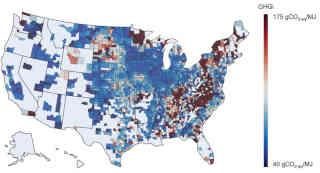By Anne Manning
Whenever you fill up your gas tank, a portion of that fuel, usually around 10%, comes from corn ethanol – the most abundant biofuel produced by the United States. The industry for corn ethanol and other biofuels has exploded since 2006, when renewable fuels were mandated to be mixed with conventional gasolines.
Biofuels like corn ethanol burn cleaner than fossil fuels and have helped U.S. cars reduce emissions since they were first added to gas tanks decades ago. But are these fuels truly sustainable? In a new paper, Colorado State University engineering researchers who specialize in life-cycle assessment of different industries provide the clearest view to date of what the true cost of biofuels really is.
The analysis was led by Jason Quinn, associate professor in the Department of Mechanical Engineering and operating director at the CSU Energy Institute. The paper’s first author is Jack Smith, who received his master’s in mechanical engineering from CSU in 2022 and his undergraduate degree in engineering science in 2015. Published in the Journal of Cleaner Production, the work evaluates the economic and environmental outcomes of the biofuels industry based on a nationwide analysis from 2017, which was the most recent year agricultural census data was available.
For the study, the researchers created a model framework that produced a techno-economic analysis and life cycle assessment for major biofuels by employing very high-resolution datasets like yield data, nitrogen fertilizer application rates, land use changes and water usage rates. The model gave them a detailed estimation of corn ethanol and soybean biodiesel sustainability performance in most counties in the United States in 2017.

A map that shows the greenhouse gas intensity of corn ethanol on a county-level basis. Credit: Jack Smith
Their analysis showed that corn and soybean fuel production and consumption amounted to a combined carbon intensity of 65.3 grams of carbon dioxide equivalent per megajoule, which is essentially the researchers’ quantifiable grade on the greenhouse gas emissions of the U.S. biofuels industry in 2017. That number was substantially less than the corresponding grade of the petroleum-based gasoline industry, which was 93 grams of carbon dioxide equivalent per megajoule.
But while biofuel production and consumption do amount to lesser carbon intensity than petroleum gasoline, the biofuels are produced at an economic cost of $6.2 billion more than gasoline. What’s more, the biofuels generate major impacts in other environmental categories compared to petroleum fuels, particularly in water use, land use and synthetic nitrogen fertilizer usage.
“I think my subjective takeaway is that the biofuels industry is good from an emissions point of view, but it could be much better,” Smith said. “The emissions reductions we’re achieving may not be worth the land and water opportunity costs.”
The true sustainability of biofuels has long been debated. The CSU analysis is the most detailed to date, with county-level geospatial resolution that spans the entire United States.
Smith said the model they’ve built can help the team with longer-term future-state analysis, with an eye toward helping inform decision-making for lawmakers and policymakers. For example, the White House has issued a Sustainable Aviation Fuel Grand Challenge, with the goal of generating at least 3 billion gallons of sustainable fuels for jet engines by 2030. The CSU researchers’ model is now being used to help the federal government reach its goals by providing best-case scenarios for different types of biofuels and their long-term benefits and consequences.
Source : colostate.edu